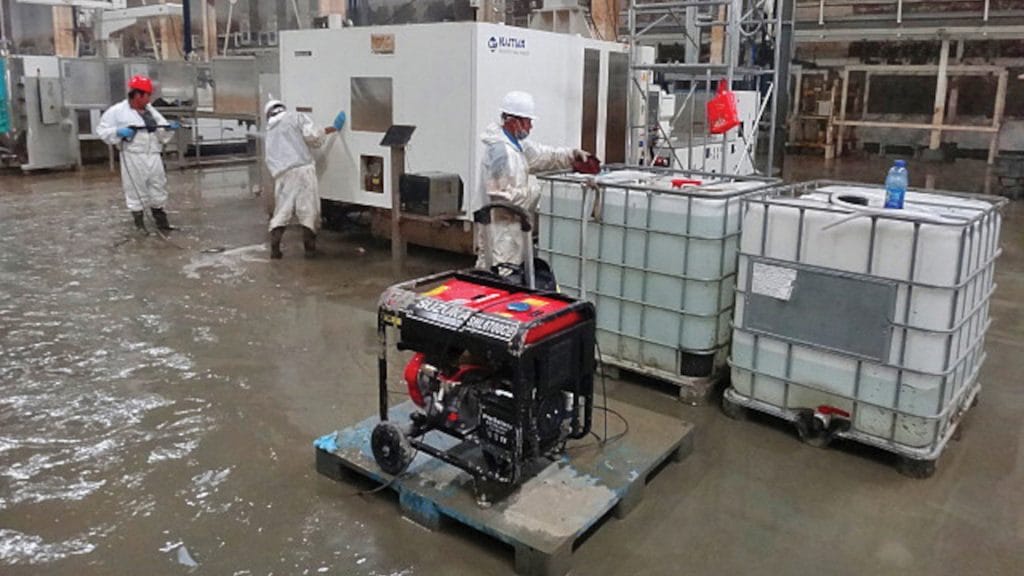What damage or loss are you investigating?
Water damage can be due to various causes such as a pipe leakage, clogged gutters or a flood. The extent of damage can vary enormously due to a number of factors:
- Source of water (E.g. ‘vertical ingress’ from a storage tank or ‘horizontal ingress’ from external flooding)
- Building fabric/ construction type
- Type of items/ assets affected
- Duration of the incident
- Environmental conditions (E.g. external temperature)
Act Before You Sink
Water damage within a property can cause corrosion, mould damage and a host of other issues, which can lead to serious structural problems and damage to property if not dealt with quickly and efficiently.
Standing water has the potential of becoming more contaminated the longer it’s left untreated. As water sits in place, the risk of microbial growth and damage to contents increases.
Why a professional water restoration service is required?
Structural drying is a scientific process that requires professional water damage training and the use of specialised instruments. Some contractors and resources may claim that a quick fix can be made on your property. This carries a risk as any residual water left after the water extraction process has been completed can still cause damage to a property if left untreated. Even with proper drying equipment in place, carpet can take 24 hours or more to dry. Moderately wet drywall can take 1-3 days. Hardwood flooring, plaster, concrete and wood may require 7-10 days to dry.
Why Choose BELFOR?
From a minor leak to a major flood, BELFOR has restored water damage properties for over 30 years in Asia. Our Recovery Specialists are trained and certified by IICRC (Institute of Inspection Cleaning and Restoration Certification) for professional water damage restoration.
Our Recovery Specialists would go onsite to assess the damaged property using these three criteria:
- Amount of Property Damage
- Degree of Contamination
- Replacement Costs vs Restoration Costs
Our water damage restoration procedures include:
- Source Elimination – The first step of any water removal process is to find the source of water and ensure it’s completely stopped.
- Identifying Type and Extent of Damage – We will inspect the building and assess what kind of damage has occurred, where it occurred and to what extent.
- Evaluating the Loss – The evaluation stage involves assessing the type of water (Category 1, 2 or 3) and level of contamination, as well as deciding what stays and what goes based on those factors. The categories of water can be split into the following:
- Category 1 – This originates from a sanitary source such as broken water supply lines, tub or sink overflow without contaminants, or falling rainwater.
- Category 2 – This type of water contains significant contamination from sources such as dishwashers or washing machines overflow/ discharge, toilet bowl oveflow (some urine, no faeces) or a broken aquarium.
- Category 3 – This is grossly contaminated and can contain pathogens, toxins, or other harmful agents; sources include sewage, waste line backup or flooding from seawater, rivers, or streams/
- Water Removal – Once the situation has been assessed, it is important to begin water extraction as soon as possible. Extraction is used to remove standing water and evaporation is used to remove excess moisture that remains.
- Drying – Once the water has been removed, effective drying must be carried out as quickly and thoroughly as possible. Both the environment (structure/area) and materials (carpet, drywall, contents) must be dried out.
- Antimicrobial Application – This is not necessary in all water damage scenarios, but can be used on a case-by-case basis and depends on level and risk of contamination.
- Loss Mitigation – We will work together with you to limit the potential for any additional damage to occur in the future. This can include things like moving or raising furniture and securing or removing other belongings that could be impacted by prolonged exposure to excess moisture.
Following these scientific processes means that BELFOR can assure you that your property has been thoroughly dried and cleaned, decreasing the risk of any further problems occurring from the water.
Hidden Water Damage Source
Our Restoration Specialists are trained to seek out water damage. Water can flow or be captured in seemingly unlikely places. If it goes undetected, it can become problems in the future. All wet materials are identified through moisture inspections involving:
- Infrared Technology
- Electronic Moisture Detection Instruments
- Thermo-hygrometers
Professional Dehumidifiers and Water Drying Equipment
BELFOR is equipped with a range of drying equipment such as air movers, air scrubbers, dehumidifiers, moisture meters, thermal imaging camera, thermo-hygrometers for water damage restoration work.
Water Incident Checklist
Following a water damage incident caused by flooding or water leakage, contact your insurance company immediately so that the cleanup and repair efforts can begin as soon as possible.
- Switch off all electrical/ electronic systems affected and secure them against being reconnected.
- In the event of a burst water pipe, turn off the main stopcock and repair the leak
- Remove excess water using a suction pump
- Use a wet and dry vacuum cleaner and/or mops/cloths to wipe the floors dry.
- Keep documents damp, do not dry them and turn off the heating until you are able to deep-freeze them. Do not use dehumidifiers.
We understand the challenges you face.
A dedicated team that provides you with personalised and optimum support at all times.
